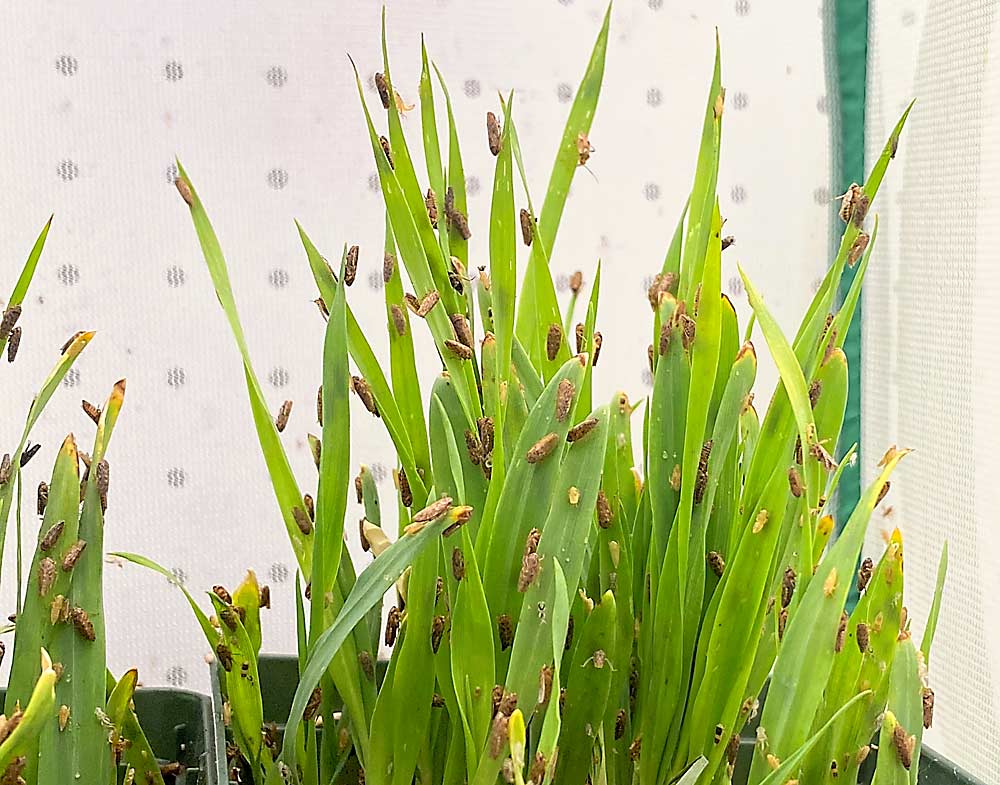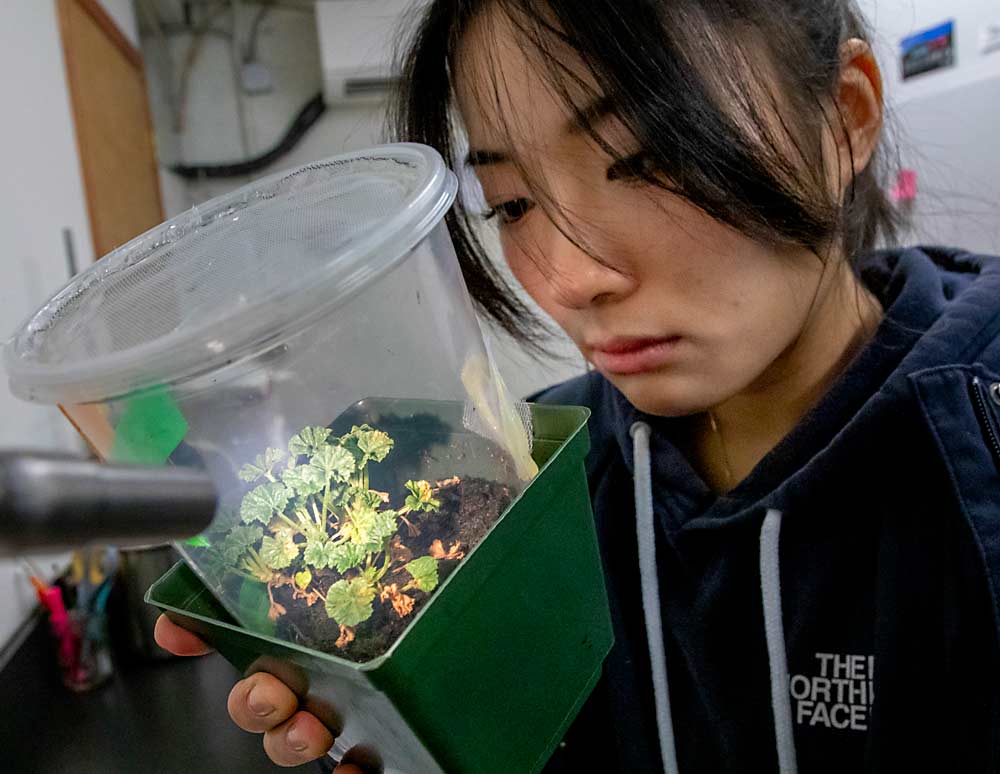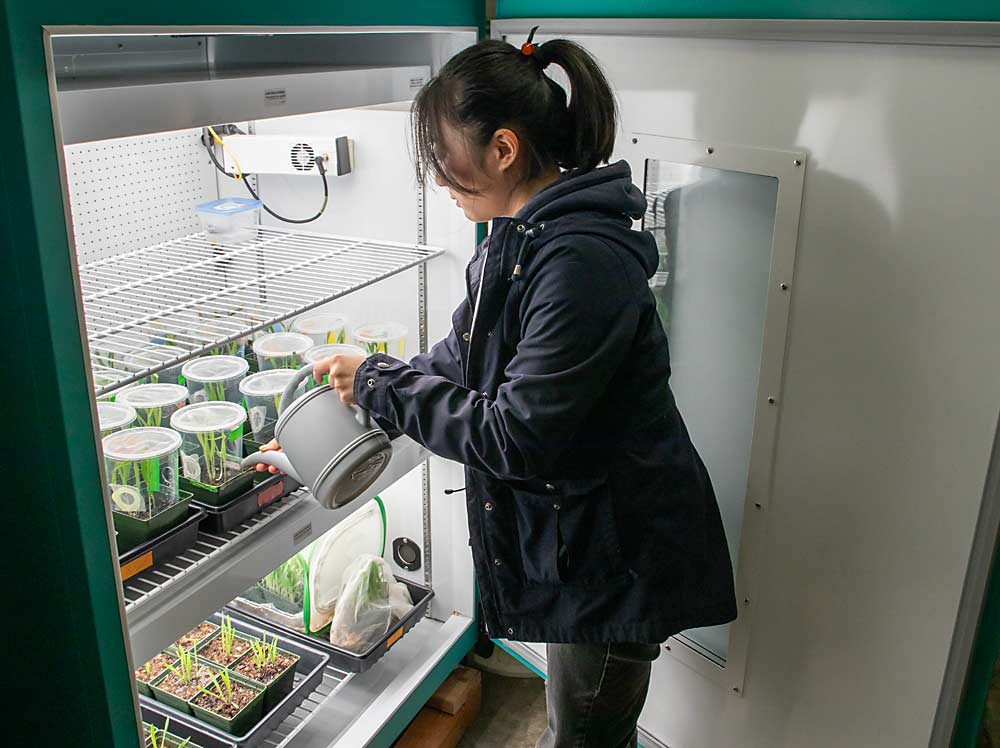Orchard pests also pose problems in the lab
[ad_1]

Pests seem indestructible in an orchard, where they breed like crazy.
Throw those bugs in a lab, and the story changes. They don’t like their diet. They won’t mate. They won’t lay eggs. And if another insect invades the colony, pesticides or predators are not an option.
Turns out keeping bugs alive long enough to study how to kill them is tricky work for tree fruit industry researchers.
“It’s a whole separate job unto itself,” said Chris Adams, an Oregon State University entomologist.

Adams keeps leafhopper colonies in his laboratory at the Mid-Columbia Agricultural Research and Extension Center in Hood River as part of the cherry industry’s attempt to combat little cherry disease, an umbrella term for X disease and little cherry virus, which both cause small, pale fruit that doesn’t properly ripen.
Several species of leafhoppers spread the phytoplasmas that cause X disease. Adams and some students are studying the life cycle of one of them, Euscelidius variegatus, and how it survives on different vegetation, such as the native yarrow plant. This particular leafhopper species is most commonly found feeding on cherry trees in the Columbia Gorge. Central Washington sites, in contrast, are typically affected by a different species of leafhopper vector, Colladonus reductus.
After catching the leafhoppers and letting them mate in a cage, researchers rear each egg on a single potted barley shoot they must water and store in climate-controlled chambers. The leafhoppers damage shoots with their piercing, sucking mouths, so staff needs a constant supply of fresh barley. Aphids inevitably cohabitate. Reproducing asexually, they can quickly overpower the colony. The scientists, of course, can’t use pesticides or predators to control the aphids because they would also kill the leafhoppers they’re trying to study.

“Fussy and difficult”
Researchers in the Columbia Gorge and other fruit-producing regions have similar struggles rearing beneficial insects.
Labs in Oregon, Washington and Michigan are raising colonies of three parasitic wasps to release as a biological control for spotted wing drosophila, an invasive cherry and berry pest.
Two wasp species — Ganaspis brasiliensis and Leptopilina japonica — only reproduce inside spotted wing drosophila larvae on fresh fruit during a narrow time window. So, researchers must inoculate fresh blueberries with drosophila eggs, introduce a female wasp to lay eggs in the larvae and relocate the emerging wasps before the berries become too moldy and inadvertently create a sticky, fuzzy trap for the wasp on which the cherry industry hangs so much hope (see “Entomologists study enemies of your enemy”).
“I’ve had them completely covered with mold,” said Maggie Freeman, Adams’ research assistant at Oregon State University.
Julianna Wilson, a Michigan State University researcher, feels Freeman’s pain. She and her team are rearing about six different insect colonies, among them the spotted wing drosophila parasitoid wasps.
“Those little, tiny wasps are super fussy and difficult,” Wilson said.
To hedge their bets against calamity, Wilson’s team has split three moth colonies into two locations. One of those is a codling moth colony collected 20-some years ago by the late Larry Gut from the grounds of the Kalamazoo Psychiatric Hospital. Never having been exposed to pesticides, the moths provide researchers a rare line of zero-resistance genetics.
Dim the lights, maybe?
Even if bugs survive in captivity, they often won’t mate.
Codling moth chastity delayed part of a project by Rob Curtiss, a Washington State University postdoctoral researcher. One of the stated objectives of his experiment was to establish a research colony, but he couldn’t get them to mate or lay eggs in captivity.
In 2023, he collected 400 pupae from cardboard bands and put them in mating arenas. No eggs. Changing tactics, he collected about 800 larvae from infested apples, transferred them to an artificial diet, let them pupate and emerge as adults in mating arenas. Again, no reproduction. He tried several different mating arena designs, all described in established scientific canon. Nothing worked.
Eventually, Curtiss ad-libbed and hung wax paper inside a plastic snack jar with diluted honey water. That worked. They fed the larvae an artificial diet, and the moths matured into adults and laid their own offspring. He had finally established a colony.
When he reported these results in January at the Washington Tree Fruit Research Commission’s Apple Crop Research Review in Wenatchee, he joked about playing romantic music for them next time.
It wasn’t his first exercise with fickle bugs. He previously studied the Asian longhorn beetle at Cornell University. The pest wouldn’t lay eggs in anything but fresh maple wood. So, every week he trekked a quarter of a mile into the woods to cut fresh logs — with snowshoes and a sled in winter — for his caged male/female pairs.
“Recipe for catastrophe”
Keeping insects alive and breeding is still only part of the battle, said Rodney Cooper, research leader at the U.S. Department of Agriculture laboratory in Wapato, where he and colleagues study Colladonus reductus, the Central Washington species of leafhopper that transmits X disease.
They have trouble keeping the pests infected. Each new generation hatches pathogen-free. That is good news for growers’ orchards, of course. But for researchers, “it’s really frustrating,” Cooper said.
Rebecca Schmidt-Jeffris, an entomologist at the Wapato lab who specializes in predators, has had struggles rearing Trechnites insidiosus, a wasp that parasitizes pear psylla. The psylla, which she also must rear, kills pear trees in the greenhouse before she can complete her research.
“It’s a perfect recipe for catastrophe,” she said.
She doesn’t try to rear Trechnites anymore; she just collects new parasitized mummies each winter from tree bands.
Schmidt-Jeffris has numerous stories of insect frustrations, from spiders eating each other to mites escaping in the lab because their cage weave is too large. To keep colonies from crossbreeding, she has been known to store them in different rooms around a lab.
“You just hope that nobody gets upset that you have random mites around the office,” she said.
—by Ross Courtney

















